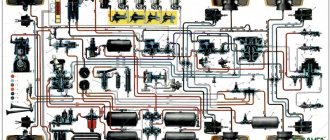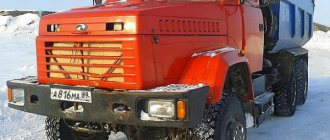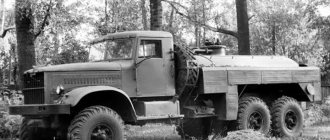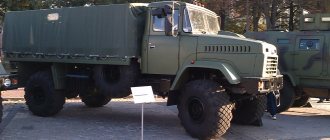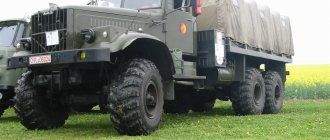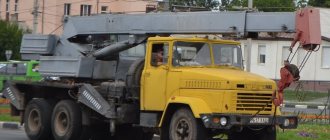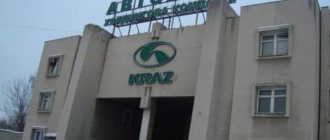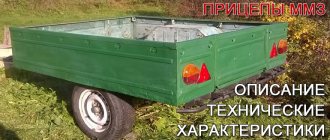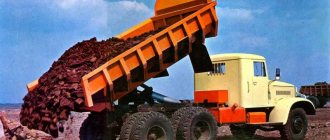KrAZ vehicles produced by the Ukrainian manufacturer have gained fame as practically indestructible, simple, suitable for use in conditions from the Far North to the tropics. Models 255 and 266 have become legendary, still in use today, despite the fact that almost half a century has passed since their production began.
Modifications of the KrAZ 6000 series
In addition to the classic version, the Kremenchug Automobile Plant produced special modifications of the car:
- the basic KrAZ-260 entered production in 1981;
- The KrAZ-260A was equipped with a YaMZ-238N diesel unit. The model did not have an additional fuel tank and BCN-1 petrol centrifugal pumps;
- The KrAZ-260V was a truck tractor with a fifth-wheel coupling and a frame that was reduced in size at the rear. Used with a semi-trailer weighing 27,500 kg;
- KrAZ-260G with extended chassis;
- KrAZ-260D is an experienced truck tractor used as part of an active road train. The Kremenchug Automobile Plant produced only two such cars;
- KrAZ-260L is an experienced timber carrier, similar in design to the KrAZ-255L1 model;
- KrAZ-6437 is a serial timber truck with a redesigned chassis design.
There are many main modifications of the KrAZ-65055, but within the framework of today’s article only the main ones will be considered.
And before starting their review, it is simply necessary to mention the KrAZ-250 model. After all, it was he who became the founder of the famous Ukrainian-made trucks. It was he who withstood all the trials and tests that were carried out back in the Soviet Union. And at that time, as we know, everything was based on GOSTs and SNIPs. It was simply impossible to receive a random award in those years.
The KrAZ-250 withstood all tests of heat (up to 55 degrees) and cold (up to -55 degrees in Antarctic conditions). And all this happened with the factory model, which was not specially modernized for such conditions.
Only a few years later, designers began to improve the truck, its individual components, power system, power plant and frame, which eventually began to be made of alloy steel. This “hero” is worthy of attention!
- KrAZ-250 is a heavy-duty truck made in Ukraine, which first saw the light back in 1978. The production of equipment did not stop until the beginning of 1992. The truck body is a functional platform in which the sides opened both at the rear and on the left side (in separate modifications). The chassis of the equipment is multifunctional - various equipment can be installed on it, for example, a truck crane, a concrete mixer, a tank truck and much more. It was this “patriot” that contributed to the creation of a whole line of KrAZ trucks.
- KrAZ-6510 is a three-axle Ukrainian heavy-duty truck with a 6x4 wheel arrangement, which has proven itself to be extremely reliable and durable. Load capacity up to 14 tons. Its purpose is to transport cargo both within the city and at intercity distances. Today, the presented vehicle is actively used by the armed forces, public utilities, agricultural enterprises and industrial sectors. It can be equipped with both a dump platform and an onboard one.
- KrAZ-65032 is a three-axle heavy-duty chassis on which a dump truck is mounted. The equipment is designed for transporting all kinds of cargo within suburban routes. Despite the standard chassis, the vehicle demonstrates an excellent level of maneuverability on viscous types of soil. It is actively used by road services, construction companies, public utilities, agriculture, etc.
- KrAZ-6140 is a three-axle Ukrainian heavy-duty truck with a 6x6 wheel arrangement. Its purpose is to transport specialized cargo (both bulk and bulk). The chassis is also designed for mounting various equipment - ATZ, car lifts, tanks for any liquids and fuel, etc. The truck stands out for its increased maneuverability and excellent cross-country ability. It is widely used in municipal organizations, armed forces, industrial enterprises, construction companies, etc.
KrAZ dump trucks
In 1958, in Kremenchug, on the basis of a plant that made combine harvesters, an enterprise was created that began producing heavy-duty vehicles. Production was transferred there from the Yaroslavl Automobile Plant. The first model produced by the new enterprise in 1959 was the KrAZ-222 dump truck.
Dump trucks are one of the priority areas of the plant. A variety of models are offered, both on an all-wheel drive chassis and with a non-driven front axle. You can choose from vehicles equipped with regular “road” tires or wide-profile ones designed for use in off-road conditions. There is also a model built on a 4-axle chassis.
Advantages and disadvantages
KrAZ vehicles have always been distinguished by their simplicity, reliability, and survivability. They are easy to repair, spare parts for them are easy to find, installation is not difficult, and the price is low.
The disadvantages of dump trucks, many of which have already become traditional, include: poor noise insulation, an ancient and ineffective ventilation system, and insufficient seat adjustment.
Numbers against the backdrop of a glorious history
At the beginning of 1977, based on the KrAZ-250 and KrAZ-260 trucks, the first prototype of the famous KrAZ-6505 dump truck was developed.
From the beginning of 1978, the newly-made three-axle KrAZ vehicle with a carrying capacity of up to 16 tons was included in the industrial plan for automobile production of the Soviet Union for the period until 1990. In the summer of the same year, a prototype of the truck was shown to a wide audience at the Exhibition of Economic Achievements of the Soviet Union.
A prototype of the KrAZ-6505 truck with reduced fuel consumption of up to 39 liters was shown at the international competition "Agroprom-1984". Next came testing and improvement of the equipment, after which the truck with a curb weight of 11.6 tons, a maximum load capacity of up to 15.5 tons and a power plant life of 250 thousand km (before the first overhaul) was again shown at VDNKh.
Tests of the modernized car took place at the beginning of 1990 in the Ashgabat area. Based on the results of tests in hot climatic conditions, the oxygen supply system for the power plant was modified. New solutions have reduced fuel consumption by more than 3.5%. And this despite the fact that the truck was operated at temperatures above 40 degrees.
At the end of the 80s, a dump truck was designed for the KrAZ-65055 model, which was made of heavy-duty steel and equipped with a balancing lift.
By the end of 1995, a whole line of dumping platforms had been created for the truck, which had a volume of 9 to 12.5 m3. Variations with rear-mounted boards and flat-sided ones were also created.
Dump truck KrAZ-65055
At the beginning of 1994, the authorities announced the official start of production of the KrAZ-6505 truck, but production of model 65055 started only in mid-1997 (only a few copies were produced). Large-scale production of the dump truck began only at the beginning of 2004, when Kremenchug designers produced about 130 vehicles.
By the beginning of 2008, more than 4 thousand copies of the equipment had already been manufactured.
Over the years of production, the Kremenchug Automobile Plant supplied about 82 thousand KrAZ-225 trucks of various modifications and versions to the Armed Forces of the USSR and allied countries. Record deliveries were recorded in 1981, when KrAZ manufactured and delivered 5,591 vehicles to the USSR Armed Forces and for export.
In total, over the entire period of production, 197,155 trucks of this family rolled off the assembly line of the Kremenchug Automobile Plant. After the collapse of the Soviet Union, the truck was produced for about two more years, however, in 1993 it was discontinued, giving way to more modern and economical models of off-road trucks .
KRAZ-255 at the British military show
The KrAZ-225B family is one of the most successful projects not only of Kremenchug automakers, but also of the entire Soviet automobile industry. It is thanks to this that “Laptezhnik” rightfully became the symbol and personification of the Kremenchug brand.
Modifications
KrAZ-65055 includes several modifications and subtypes:
- KrAZ-65055 type I – the initial version for transporting cargo up to 16 tons;
- KrAZ-65055 type II – transportation up to 16 tons, reinforced rear suspension;
- KrAZ-65055 type III – transportation of up to 18 tons (the latest and most common version).
The main characteristics of the modifications are similar.
KrAZ is used in various works
There are two types of model depending on climatic operating conditions:
- Type “U” - can withstand up to 50 degrees of heat.
- Type “T” – withstands harsh conditions with temperatures down to -45 degrees.
The successor to the 65055th model is the KrAZ S18.0 “Gornyak”. It is equipped with a Cummins L-360 engine. Thanks to the re-equipment of the body, the maximum load for the Gornyak is 20 tons.
Be sure to read: KRAZ 255 “Laptezhnik”
Cabin of KrAZ-65055: overview of the workplace
The cabin of the KrAZ-65055 dump truck does not stand out as anything special among its competitors in this class. The short cabin without a berth has not become more spacious since the 1988 tests. If we compare the convenience, then it is only slightly inferior to its foreign classmates.
The cabin has a third seat. It is equipped with two seats for passengers and a driver's seat. All seats are sprung, which provides a decent level of comfort even when driving off-road.
The rear view mirrors on the car demonstrate a good level of visibility. Even at maximum load, the “picture” in the mirrors does not lower or rise when overcoming a slope, which is essential for many of KrAZ’s fellow trucks.
When driving on asphalt or hard ground, the cabin shows its best side - it is quite soft and is not subject to sudden swings, which prevents the driver from getting tired even during the longest transports.
Each door also has auxiliary handles that greatly simplify access to the cabin. The engineers did not create pneumatic cylinders for the cab or spring struts - “a sort of Trojan horse” - affectionate comments from the truck owners.
The dashboard of the dump truck is considered one of the most informative and driver-friendly among all analogues produced in the USSR. Its design is somewhat reminiscent of foreign competitors, but only until 1998, after which almost all trucks in Europe began to be equipped with electronics and other devices that were then unavailable to the USSR.
The plastic in the cabin is quite good - at a speed of 60 km/h, even over rough terrain, it does not creak or try to bend when touched by hand.
"Important!" The cabin of the KrAZ-65055 dump truck is not intended for transporting heavy loads over long distances. Its obvious disadvantage is that it is poorly protected from the effects of headwinds and is not comfortable enough. The control pedals are quite tight and hard, and the seat does not properly support your back posture. The result is simple - the driver will get tired after 150-200 km of non-stop driving.
Engine
The KraZ-260, taking into account significant modernization, required a powerful power plant. As a result, the YaMZ-238L 8-cylinder multi-fuel unit with turbocharging was chosen. The car was often used in difficult road conditions (dirt, sand, dust, etc.), so an innovative solution was used in the engine design, including automatic dust extraction and two air filters with a two-stage cleaning system.
The exhaust system has also undergone modernization. Instead of a muffler, a supercharger turbine appeared here. To facilitate the start-up of the power plant in cold weather, the unit was equipped with an electric torch-type device “Thermostart” and a pre-heater.
The placement of the unit was not very convenient. In order to remove the engine, it was necessary to dismantle the cabin.
- working volume – 15 l;
- rated power - 300 hp;
- rotation speed – 2100 rpm.
An engine with excellent performance values called YaMZ-238 is used as a power plant in the car. Year of development - 1950, it was designed at the Yaroslavl Motor Plant.
The most common diesel is used as fuel. Moreover, its quality is not important: in the working chamber, both ECTO class fuel and old Soviet diesel fuel will burn equally well.
We invite you to consider the advantages
cultivators Viking 685
and other previous models.
From the following article you will learn the technical characteristics of KamAZ-53215.
YaMZ-238 has the following design features:
- the modern version is equipped with turbocharging (previously this option was not installed);
- the engine can be equipped with 6 or 8 cylinders;
- number of working cycles – 4;
- a mechanical injection pump is used as a power supply system;
- the cylinder block is made of cast iron;
- the running engine is cooled using liquid;
- all cylinders are located in relation to each other at an angle of 90 degrees in a V-shape;
- bottom mechanism type – OHV with overhead valves;
- distance from bottom to top dead center – 140 mm.
Since the most common mechanical fuel injection pump is used as the power supply system for the combustion chambers, each cylinder is equipped with its own pumping station. All of them carry out direct injection.
It is due to this that such a large torque is achieved - 1,765 N×m. The power of the YaMZ-238 engine (its basic version) is 177 kW or 240 hp. With.
The intake lines are located directly in the camber of the cylinder block. The OHV is located next to the crankshaft. It is driven by a pair of gears that are mounted in the front of the engine housing.
The number of valves is a pair for each working cylinder.
The designers paid special attention to the connecting rod racks: they are located at an angle of 90 degrees in relation to the crankshaft. This is what allows for fully synchronized flashes, which makes the engine operate very smoothly and quietly.
The cylinder liners themselves are made of high-strength cast iron, thanks to this the engine life is increased many times, which allows major repairs to be carried out only once per 800 thousand km.
The crankshaft is made of high-strength steel by hot stamping. Even and odd-numbered crank mechanisms are located relative to each other at an angle of 180 degrees (while being in the same plane).
More recently, KrAZ trucks were produced with new, modified engines based on YaMZ-238. Their design allows them to comply with EURO-3 environmental standards.
Further modification to meet higher environmental standards is practically impossible, according to the developers. Nevertheless, this power plant continues to be used in almost all KrAZ models.
The maximum speed developed by the truck is 71 km/h. Up to 60 km/h acceleration time is 40 seconds.
TIPPING EQUIPMENT:
| Platform volume, m 3 | Tailgate | Platform heating |
| 10.5 for type 1 | There is | There is |
| 12 for type 2 | There is | There is |
| 16 for type 3 | There is | There is |
The KrAZ platform is made of alloy steel 09G2S, reinforced, bottom thickness is 10 mm. The subframe is made of alloy steel. The tipping mechanism is of the balancing-lever type; piston hydraulic cylinder, single-rod with a safety valve against excess loads.
Device
The KrAZ-260 is characterized by a hood arrangement. On the transportation platform there are folding benches, arches and an awning. It itself is made of durable metal and is complemented by a side that opens from the back. The model is available in different types of bodies, which makes it more versatile.
Thanks to the all-wheel drive system, the vehicle's maneuverability has increased significantly. This was also facilitated by a new tire pressure monitoring system, single-pitch tires and short overhangs.
The model is equipped with a double-disc dry clutch. The drive of this unit consists of the main and working cylinders, a suspended pedal, pneumatic and hydraulic drives. For this element, monitoring the volume of brake fluid and the condition of the pistons and cuffs is important.
The KrAZ-260 transfer case is located behind the gearbox. A small cardan shaft is used for connection here. The element is suspended on three supports using rubber pads and brackets. The transfer case includes two gears and is a gearbox with specific spur gears and three shafts.
The truck's driveline has 4 driveshafts connecting the gearbox and transfer case. They differ in the placement of parts and sizes.
The design of the KrAZ-260 includes intermediate, rear and front drive axles. The differences between them are manifested in the main gear, drive parts, pinion shaft and crankcase. The main purpose of the front drive axle is to supply force to the wheels through the main gear and angular velocity joints.
The brakes of the model have a drum structure. When the parking brake is applied, spring energy accumulators are activated. The auxiliary brake is pneumatically driven.
The KrAZ-260 cabin is made of all-metal sheet. It can accommodate up to three people and is equipped with ventilation and heating. The driver's seat is height adjustable. You can also control the tilt angle and distance to the steering wheel. The seat has a hydraulic shock absorber and a sprung design. The power steering makes it easy to steer a heavy truck.
A headlight is installed on the roof of the car, performing the function of a finder. The basic package also includes a radio.
The KrAZ-255 uses a standard model as a clutch, which is used on all vehicles with similar overall dimensions and operating specifications. It has the following technical characteristics and properties:
- clutch type – friction;
- two disks engage;
- the design uses cylindrical springs;
- The discs themselves operate without lubrication, there is no oil bath.
Since the KrAZ engine was developed quite a long time ago, it does not provide for the installation of an automatic transmission. That is why the truck is equipped only with a manual transmission. It has the following design features:
- fixed shaft axes are used;
- there are gears that are in constant mesh (excluding first gear and reverse gears);
- the box is three-way;
- number of gears – five;
- There are synchronizers that compensate for the lack of a divider (used in KamAZ) and work in second-third and fourth-fifth gears.
The transfer case has the following features and technical specifications:
- type – mechanical;
- includes power take-off shaft (for winch);
- There are two stages and a center differential.
The cardan transmission consists of several main parts:
- open type shafts;
- intermediate supports;
- cardan shafts.
The KrAZ is equipped with three drive axles, and it is thanks to them that it is famous throughout the world for its amazing maneuverability.
The design of the front axle has some features: it contains CV joints (additional constant velocity joints). They are responsible for transmitting torque to the front wheels during turning.
Attention! On the middle axle there is a special platform intended for mounting the rear axle driveshaft support.
The front and rear suspensions have different designs and technical characteristics:
- the front one rests on two semi-elliptical springs, which are equipped with a pair of shock absorbers (hydraulic, working in both directions);
- The rear suspension is mounted on two semi-elliptical longitudinal springs (equipped with three pairs of reaction bars).
The brake system is standard, it differs only in its rather large weight.
It includes the following elements:
- brake pads;
- brake drums;
- pneumatic drive and vacuum booster;
- additional brake motor (decelerates).
The braking distance of a car at various weights:
- at a speed of 40 km/h – 17 m;
- at a speed of 40 km/h with a trailer – 18.5 m.
Specifications
Since the creation of a dump truck and the period from experiments to mass production takes more than one year, some components were modified on the fly. This applies to the clutch, engine, brakes. Thus, the brake system was initially designed as a drum brake system, but since the 2000s it has been a disk brake system, driven by a pneumohydraulic mechanism. Accordingly, the pneumatic system diagram has also been improved: in the latest version it is a separate pneumatic drive. The handbrake is activated by a hand crane. The spring energy accumulator increases the efficiency of the service brake. The diagram of the air system that supplies air to the engine includes a cylinder block and 2 filter elements. The radiator is liquid. The exhaust is removed through pipes and pipes made of special steel that does not react to “aggressive” gas components.
Engine
The 65055th model was produced with two types of turbocharged diesel power units produced by YaMZ.
YaMZ-238D (it was equipped with the first experimental model), which has the following characteristics:
- volume – 14.86 l;
- power – 330 l. With.;
- 8 cylinders are arranged in a V-shape;
- torque – 1225 Nm.
YaMZ-238DE2 is found on newer models. The power, volume and cylinder system are identical. The difference is in torque: here – 1274 Nm. Complies with international Euro-2 standards.
Refueling volumes:
- fuel tank - 2 pieces, each 250 l;
- oil tank – 50 l;
- cooling system – 38 l;
- lubrication system – 32 l.
Fuel consumption is standard for the heavy class - up to 32 liters at a speed of 60 km/h per 100 km. At maximum speed (90 km/h), the dump truck consumes more - up to 37 liters.
Transmission
The experimental model was equipped with a transfer case from YaMZ, model 2380. However, its power resources were not enough. Production units are equipped with an improved mechanical YaMZ-2381:
- 8 steps;
- there is a power take-off (to drive the pump of the platform tilting mechanism);
- speedometer sensor – electronic;
- Gear shifting is facilitated by a pneumatic booster;
- KrAZ-6500 gearbox with a divider, 2-range, the gearbox is located on the shift lever (does not affect reverse mode).
The clutch basket is also made by YaMZ. The single-disc clutch turned out to be rather weak for a heavy truck: it is equipped with a dry 2-disc, friction clutch (236, 238 YaMZ models), reinforced by a PGU. KrAZ-65055 driven clutch disc, diameter 430 mm.
The cardan transmission mechanism is open type, number of shafts – 2. The intermediate support is equipped with a hatch for completing a 1-speed power take-off. The axles (drive - middle and rear) are 2-speed, with a center differential on the middle axle housing. The fifth wheel coupling mechanism is of a semi-automatic type; there are 2 grips under the king pin, secured with a locking device.
Weight and dimensions:
- Height – 2.87 m.
- Width – 2.5 m.
- Length – 8.35 m.
- Ground clearance – 0.29 m.
- Hollow weight – 30.6 tons.
- Load capacity – up to 16/18 tons.
- The allowed load is 6.1 tons on the front axle, 24.5 tons on the rear axle.
Chassis
The wheel arrangement corresponds to the “6 by 4” formula. It is driven by rear wheel drive. A special asset is the springs that balance the rear suspension, which require continuous operation of up to 350 thousand km. Main parameters of the KrAZ-65055 chassis:
- design – frame;
- suspension – dependent (rear and front);
- the springs are semi-elliptical, the front suspension has hydraulic shock absorbers;
- The wheels are disc (II.00R20), and a spare wheel is located behind the cab on a holder with a mechanical drive.
Reviews from KrAZ-65055 owners: advantages and disadvantages
Reviews from the owners of this truck say approximately the same thing.
The car is of high quality and extremely reliable, but only with appropriate maintenance. Let us remind you once again that the period before a major overhaul is as much as 250 thousand kilometers, which not every competitor will demonstrate.
Fuel consumption does not exceed GOST standards and ranges from 32 to 37 liters per 100 km, which depends on the owner’s driving style.
The carrying capacity of a vehicle designed for the heavy class is excellent. The load weighing 17 tons is not particularly noticeable; the truck behaves firmly and confidently.
The main advantages of KrAZ-65055
The car's interior is comfortable and of high quality, all controls are located at the driver's fingertips. The plastic parts are not rigid and do not creak when moving. Thanks to the almost straight windshield, visibility is excellent.
The engine is very torquey and very reliable. Repair work is carried out very rarely. The capacity of the body is impressive; not every competitor of KrAZ (especially Chinese) can demonstrate such indicators. The factory specifications indicate that the car cannot transport more than 20 tons. Practice has shown quite the opposite - a well-maintained KrAZ-65055 can transport cargo weighing up to 27 tons. What competitors definitely won’t show.
The main disadvantages of the KrAZ-65055
Weak distribution system of warm air from the heater. It can be corrected by installing foreign analogues. Sound insulation is also weak. It can be fixed by installing other rubber bands, in particular from KamAZ. Otherwise the car is extremely reliable.
Specifications
Dimensions:
- length – 8350 mm;
- width – 2500 mm;
- height – 2870 mm;
- turning radius – 11000 mm.
The curb weight of the car is 12,300 kg. Axle load distribution:
- front axle – 4200 kg;
- rear axle – 8100 kg.
Gross weight – 28400 kg. Axle load distribution:
- front axle – 5900 kg;
- rear axle – 22500 kg.
The equipment is equipped with platforms with a volume of 9, 10.5 or 12.5 cubic meters. For later versions, 16 cubic meter platforms are available. Load capacity is 16000-18000 kg.
The maximum speed is 90 km/h, the maximum climbability is 30%.
Tire size: 12.00R20 (320R-508).
KrAZ-65055: price of new and used
When compared with foreign analogues, the cost of the KrAZ-65055 is significantly lower and more loyal.
As of today, production of the KrAZ-65055 truck has been stopped. Only modifications of it go into series. Nevertheless, it is still possible to purchase a KrAZ-65055 vehicle. You are unlikely to find new models, but there are absolutely no issues with used cars.
The price here directly depends on the year of production and actual mileage:
- A truck produced in 1997-2003 (mileage from 300 to 400 thousand km) can be purchased for 230-340 thousand rubles. Cars with cargo platforms will cost 30-70 thousand more.
- A truck produced in 2003-2009 (mileage up to 200 thousand km, because modernized models) can be bought for 470-650 thousand rubles.
- Models produced in 2010-2014 (mileage does not exceed 150 thousand km) can be purchased for 790-1250 thousand rubles.
The KrAZ-65055 truck has earned its fame - it has come a long way from the Soviet Union to the present day. He is one of those who did not give up in the past and was not forgotten after the collapse of the USSR. It is deservedly considered the most successful and reliable truck from the Ukrainian manufacturer. It has incorporated all the most current and developed innovations of designers over the years and is not only not inferior to its foreign rivals, but also surpasses them in many nuances, especially in reliability and cost of repairs.
After the collapse of the Soviet Union, the popularity of the KraZ-260 decreased somewhat. However, even now there are many used versions of this model on the market. The cost of trucks produced in 1991-1992 is 400-700 thousand rubles. Some modifications will cost much more – up to 1.3 million rubles. The difference is due to the condition and installed equipment.
Renting a car will cost 1000 rubles/hour.
Analogs
Analogues of the KraZ-260 include the ZIL-131 and KamAZ-4310 trucks.
Price
It is almost impossible to buy a new KrAZ-65055 today. Prices for a used dump truck are quite reasonable:
- a car until 2010 will cost an average of 450-650 thousand rubles;
- after 2010 – up to 1.3 million rubles.
With the history of its modernization, the KrAZ-65055 embodies the transition in the automotive industry from the Soviet era to a new one - electronic, requiring more power. This is one of the best modern products of the Ukrainian automobile industry, which meets all international standards, while having a low price.
